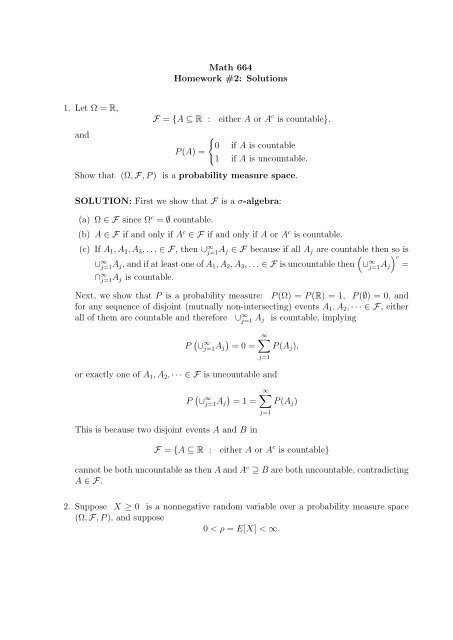Math 664 Homework #2: Solutions 1. Let Ω = R, F = {A â R : either A ...
Math 664 Homework #2: Solutions 1. Let Ω = R, F = {A â R : either A ...
Math 664 Homework #2: Solutions 1. Let Ω = R, F = {A â R : either A ...
You also want an ePaper? Increase the reach of your titles
YUMPU automatically turns print PDFs into web optimized ePapers that Google loves.
<strong>Math</strong> <strong>664</strong><strong>Homework</strong> <strong>#2</strong>: <strong>Solutions</strong><strong>1.</strong> <strong>Let</strong> Ω = R,andF = {A ⊆ R :P (A) =<strong>either</strong> A or A c is countable},{0 if A is countable1 if A is uncountable.Show that (Ω, F, P ) is a probability measure space.SOLUTION: First we show that F is a σ-algebra:(a) Ω ∈ F since Ω c = ∅ countable.(b) A ∈ F if and only if A c ∈ F if and only if A or A c is countable.(c) If A 1 , A 2 , A 3 , . . . ∈ F, then ∪ ∞ j=1A j ∈ F because if all A j are countable then so is( ) c∪ ∞ j=1A j , and if at least one of A 1 , A 2 , A 3 , . . . ∈ F is uncountable then ∪ ∞ j=1A j =∩ ∞ j=1A j is countable.Next, we show that P is a probability measure: P (Ω) = P (R) = 1, P (∅) = 0, andfor any sequence of disjoint (mutually non-intersecting) events A 1 , A 2 , · · · ∈ F, <strong>either</strong>all of them are countable and therefore ∪ ∞ j=1 A j is countable, implyingP ( ) ∑ ∞∪ ∞ j=1A j = 0 = P (A j ),j=1or exactly one of A 1 , A 2 , · · · ∈ F is uncountable andP ( ) ∑ ∞∪ ∞ j=1A j = 1 = P (A j )This is because two disjoint events A and B inj=1F = {A ⊆ R :<strong>either</strong> A or A c is countable}cannot be both uncountable as then A and A c ⊇ B are both uncountable, contradictingA ∈ F.2. Suppose X ≥ 0 is a nonnegative random variable over a probability measure space(Ω, F, P ), and suppose0 < ρ = E[X] < ∞.
Define for every A ∈ F,Q(A) = 1 ∫ρAX(ω) dP (ω)Show that (Ω, F, Q) is another probability measure space, andQ ≪ P,i.e. Q is absolutely continuous with respect to P .SOLUTION: First, we check that Q is a probability measure:Q(∅) = 1 ∫X(ω) dP (ω) = 0.ρ∅For any sequence of disjoint (mutually non-intersecting) events A 1 , A 2 , · · · ∈ F,Q ( ∫)∪ ∞ 1j=1A j = X(ω) dP (ω) =ρ ∪ ∞ j=1 A j∞∑j=1∫1X(ω) dP (ω) =ρ A jby the Monotone Convergence Theorem. Finally,Q(Ω) = 1 ∫X(ω) dP (ω) = ρ ρρ = <strong>1.</strong>Next, we show that Q ≪ P :if P (A) = 0 then Q(A) = 1 ρΩ∫AX(ω) dP (ω) = 0.∞∑Q(A j )j=13. Suppose, for p > 0, a sequence of random variables X n → 0 in L p . That is∫E[|X n | p ] = |X n (ω)| p dP (ω) → 0 as n → ∞.Show that X n → 0 in probability: for any ɛ > 0,P (|X n | ≥ ɛ) → 0 as n → ∞.SOLUTION: By Markov inequality,P (|X n | ≥ ɛ) = P (|X n | p ≥ ɛ p ) ≤ E[|X n| p ]ɛ p → 0 as n → ∞.
4. Use Jensen’s inequality and size-biasing to show that if X ≥ 0 is a random variablesuch that0 < ρ = E[X] < ∞, σ 2 = V ar(X) < ∞, and σ ρ ≤ Mfor a given constant M > 0, thenρ 3/2 ≤ E[X 3/2 ] ≤ C · ρ 3/2for some constant C > 1, e.g. C = √ 1 + M 2 .SOLUTION: Since ( x 3/2) ′′and by Jensen’s inequality,= 34 √ x > 0 for x > 0, function x3/2 is convex on [0, ∞)ρ 3/2 ≤ E[X 3/2 ]For the upper bound, we will use size-biasing. <strong>Let</strong>∫xν(A) =ρ dµ(x) ∀A ∈ BThen ν is a probability measure over (R, B), and ν ≪ µ.ANext, we apply Jensen’s inequality for the concave function √ x and obtainE µ [X 3/2 ] = E µ [X · √X]= ρ · E ν [ √ X] ≤ ρ · √Eν [X] = ρ ·√E µ [X 2 ]ρ= ρ ·√σ 2 + ρ 2ρThereforeE µ [X 3/2 ] ≤ ρ 3/2 ·√σ 2 + ρ 2ρ 2 ≤ ρ 3/2 · √1+ M 2
















